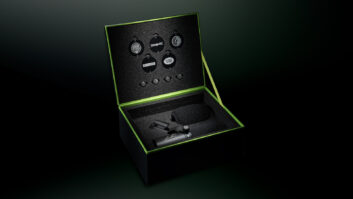As the first two-way, universal-fit earphone for in-ear monitoring applications, Shure’s second-generation E5 earphone-priced at an affordable $590-may change the way users feel about in-ear monitors. The E5 was developed in conjunction with Westone Labs and ultimate Ears. Each of the E5’s ear-buds is a true two-way design, equipped with dual balanced armature or “ribbon” drivers and offering greater fidelity than single-driver transducers.
FEATURESEverything about the E5 invites comparison to its less expensive sibling, Shure’s $190 E1. Whereas the E1 felt flimsy, the E5 is ruggedly finished. A durable, clear cable replaces the E1’s twisted beige wire, and the entire product is translucent, giving it an “iMac” feel down to its 11/48-inch headphone jack. Like the E1, the E5’s generous 5-foot wires are permanently attached to the transducers. The hardest adjustment is getting used to the stiffness of the rugged cable after the suppleness of the less substantial wires found on most other IEM products.
Supplied accessories include two fitting options. Most familiar are the disposable foam tips that look like yellow earplugs, which offer a degree of isolation that’s good enough for many users. There are also three sizes of reusable PVC flanges which, while not comfortable to me, offer the benefit of one-handed insertion and are more easily kept clean.
As with the E1, custom sleeves (#58) of clear silicone offer the best fit and are available for an extra $100 from Westone in Colorado Springs, Colo. (800/364-9115). Molded from ear impressions made by a Westone-affiliated audiologist (included in the $100 price), these slip over the tip of each earphone. The improvement in comfort and the ease with which they can be fitted or removed from one’s ears make these a necessity for any serious user. The sleeves also help protect the tiny filters inside the E1’s or E5’s sound ports. But the best argument for custom sleeves is that they provide slightly better isolation, allowing for lower monitoring levels than with the generic tips.
THE SOUNDAcross its full frequency range, the E5 is about 5 dB hotter than the E1, with a smoother response. The E5 has extended highs and lows, while the midrange presence peak found in most armature transducers is wider here, offering a balanced yet aggressive sound. Did I mention that they’re loud? With this kind of output potential, there’s enough horsepower for anyone.
I also compared the E5s to Westone’s top-of-the-line ultimate Ear uE5, which is one of my favorites and costs a couple hundred dollars more. Both were produced with much input from IEM engineer and designer Jerry Harvey. The new E5 has more high-mids, is brighter and a bit louder than the contoured sound of the ultimate Ear. Though the uE5 is gentler and smoother to my ear, others may prefer the E5’s tilt toward the highs.
users will find that even rudimentary EQ used as tone control can tailor the E5’s response to suit a variety of tastes. The E5’s greatest hidden feature might be that its robust response will make it favorable to skilled operators who can tailor EQ adjustments to each listener. You wouldn’t use a wedge or sidefill without tweaking the graphic, and the next frontier for IEMs is the use of mastering EQ to create a custom fit to each user’s hearing and preferences.
Who will like the E5? I would compare its sound to that of a KF-850 and imagine that artists will earn a similar level of acceptance to what is required with that unit. Some musicians are never content with IEMs until they are supplemented with a “thumper” or subwoofer, but anyone using single-driver earphones should give the E5s a try. First-time users can audition the E5 without having to invest in a custom product. Once you add in the price of the custom sleeves, the E5s are not much less expensive than other high-quality two-way ear molds, but for artists who play rough onstage, these earphones are built to take it.
Shure, 222 Hartrey Ave., Evanston, IL 60202; 847/866-2200; fax 847/866-2279; www.shure.com.






